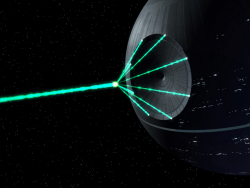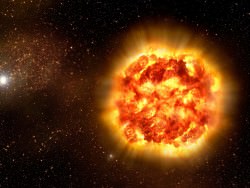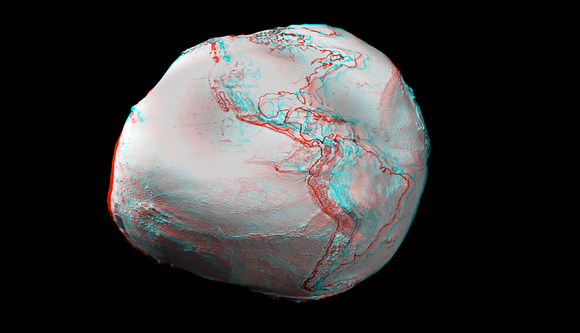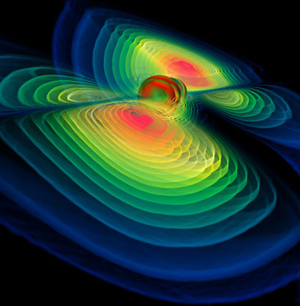In the movie Star Wars, the Darth Vader’s Death Star destroyed a planet. Could this really happen?
You’ve watched Star Wars right? Is that still a thing? With the Starring and the Warring? Anyway, there’s this classic scene where the “Death Star” sidles up to Alderaan, and it is all like “Hey Planetoid, you lookin’ fine tonight” and then it fires up the superlaser and destroys the entire orb in a single blast. “BOOM”. Shortly followed by some collective group screaming on the interstellar forceway radio.
This is generally described as “science fiction”. And when you’re making up stories, anything you like can happen in them. George Lucas’ hunger for your childhood toy money wasn’t hampered by the pesky constraints of physics in any meaningful way.
Here at the Guide to Space, we get to take our own flights of fancy and pointlessly speculate for your amusement. That’s our job. Well, that and snark. Let’s consider what it would actually take to destroy a planet with a ‘pew pew’ style laser beam, and what kinds of energy would need to be harnessed in a fully armed and operational battle station.
Let’s go back and carefully review our “evidence”. The Death Star drifts in, charges up all its lasers into a superlaser blast focused on Alderaan. The planet then detonates and chunks fly off in every direction just like the pie eating contest in “Stand By Me”.
What we saw was every part of Alderaan given enough of a kick so that it was traveling at escape velocity from every other part of the planet. If the Death Star hadn’t delivered enough explosive energy, the planet might have fluffed up for a moment, but then the collective gravity would suck it all back in together, and then the slightly re-arranged, and likely now uninhabited planet would continue orbiting its star.
You can imagine doing this the slow way. Take each continent on Alderaan, load it up into a rocket and blast that rocket off into space as though it was on escape trajectory from the planet. Sure, you’d would need an incomprehensible number of rocket launches to get that material off the planet. But hey, midichlorians, blue finger lightning and ESP.
Fortunately, as you carted away more and more of the busted up rock, it would have less mutual gravity, and so the rocket launches would require less and less energy to get the job done. Eventually, you’d just be left with one last chunk of rock that you could just force ninja kick into the neighboring star.

So how much energy is that going to take? Well, there’s an “easy” calculation you can make. The energy you’d need is equal to 3 times the gravitational constant (6.673 x 10^-11) times the mass of the planet squared divided by 5 times the planet’s radius. Do this math for an Earth-sized/mass world, and let’s see that’s, two and one, carry the 5… and you get 2 x 10^36 joules. That’s a two followed by 36 zeros in joules. Is that a lot? That sounds like a lot.
Well, our own Sun puts out 3 x 10^26 joules per second. So, if you poured all the energy from the Sun into the task of tearing apart the Earth, it wouldn’t have enough energy to do it. In fact, you’d need to focus the light of the Sun for a full week to get that level of planet destruction done.
According to ancient Star Warsian dork scholars, the Death Star (SOLUS MORTIS) is powered by a hyperreactor with the output of multiple main sequence stars. So there you go, problem solved. It’s the size of a small moon, but it’s more powerful than many stars. Of course it can destroy a planet.

The Death Star clearly destroyed Alderaan. We watched it explode. I saw it, you saw it. We heard the screams of millions of souls cry out. It happened. But what if it wasn’t a beam thingy?
Our math is good, but clearly we’re not enlightened enough to comprehend the true wisdom hidden within the Lucasian scriptures. Perhaps the Death Star’s superlaser was just a targeting laser. Directing the placement of gigantic antimatter bomb. According to Ethan Siegel, from “Starts With a Bang,” you’d only need 1.24 trillion tonnes of antimatter.
Imagine you made a bomb out of that much antimatter iron – if that’s even a thing – you’d only need a sphere about 3 km across. If the Death Star is 150 km across or so, they could carry a bunch of these. Very carefully. Like super carefully. Okay, maybe it’d be a good idea if everyone took off their boots, and make sure they only talked with their inside voices.
Obviously, Star Wars is a story, so anything, ANYTHING can happen. The future is unknown, and we might discover all kinds of weirdo physics and harness them into all kinds of powerful weapons. I’m only suggesting, that a space station capable of deploying a week’s worth of solar energy in a single second might be a stretch. And maybe, George, if you just done a little back of the napkin math, we wouldn’t be talking about this right now. Also, maybe no Ewoks. I’m just saying.
Where do you stand on the feasibility of imaginary space station weaponry? How big a planet can your imagination destroy?



